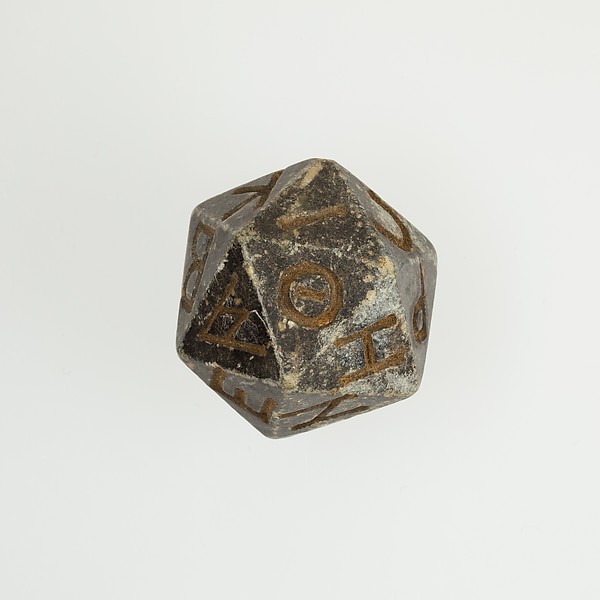Twenty-sided dice
When I first saw the image of a 20-sided die, I assumed a Dungeons and Dragons player faked a historical artifact. However, the image comes from a Metropolitan Museum of Art exhibit as donated in 1910. Listing as dating back to 300-30BC, rolling 20-sided dice is very old.
My inference (20-sided = DnD) is grounded in the source of twenty-sided dice origins for the tabletop roleplaying game. The game relies on dice to determine probability and found use of educational dice sets for symmetrical polyhedral dice, which traditionally contained 4-sided, 6-sided, 8-sided, 12-sided and 20-sided dice (technically these are called tetrahedron, hexahedron, octahedron, dodecahedron and icosahedron). These are the Platonic solids, each having the same number of faces meeting at each vertex. Ancient Greek philosophers, probably intrigued by the beautiful symmetry of these shapes, associated the elements with the Platonic solids. Water was associated with the 20-sided die. Little did they know, "With few exceptions, the shells (capsids) of sphere-like viruses have the symmetry of an icosahedron."
So the 20-sided dice we associate with a board game originated from math sets that described the theories of ancient Greek philosophers, which actually depict molecular structures....
My inference (20-sided = DnD) is grounded in the source of twenty-sided dice origins for the tabletop roleplaying game. The game relies on dice to determine probability and found use of educational dice sets for symmetrical polyhedral dice, which traditionally contained 4-sided, 6-sided, 8-sided, 12-sided and 20-sided dice (technically these are called tetrahedron, hexahedron, octahedron, dodecahedron and icosahedron). These are the Platonic solids, each having the same number of faces meeting at each vertex. Ancient Greek philosophers, probably intrigued by the beautiful symmetry of these shapes, associated the elements with the Platonic solids. Water was associated with the 20-sided die. Little did they know, "With few exceptions, the shells (capsids) of sphere-like viruses have the symmetry of an icosahedron."
So the 20-sided dice we associate with a board game originated from math sets that described the theories of ancient Greek philosophers, which actually depict molecular structures....


0 Comments:
Post a Comment
<< Home